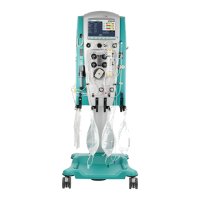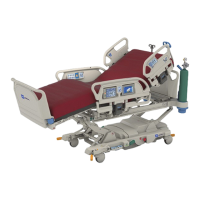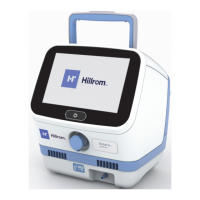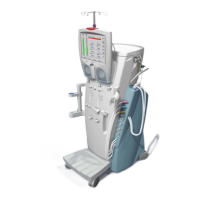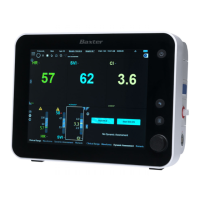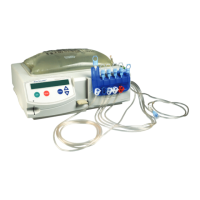
Do you have a question about the baxter HomeChoice and is the answer not in the manual?
| Manufacturer | Baxter International Inc. |
|---|---|
| Power Requirements | 100-240V AC, 50/60 Hz |
| Type | Automated Peritoneal Dialysis Machine |
| Therapy Modes | Automated Peritoneal Dialysis (APD) |
| Alarms | System Error |
| Memory | Stores treatment data |
| Connectivity | Data transfer via USB |
Lists contact numbers for technical support and dialysis centers.
Details potential side effects and conditions where use is not advised.
Highlights critical safety information that can cause harm.
Explains symptoms and causes of overfilling (IIPV) and how to manage it.
Describes the general functions of the GO, STOP, ENTER, and Up/Down buttons.
Steps to perform before initial use, checking for damage and included components.
Instructions for placing the cycler on a stable surface and ensuring a grounded outlet.
Explains the importance of grounding and proper outlet connection for electrical safety.
Instructions for manually programming or reviewing therapy settings.
Outlines the basic steps to review or change therapy settings using the system buttons.
Details the step-by-step process for changing Total Volume and Therapy Time settings.
Continues the step-by-step guide for changing Last Fill Volume, Dextrose, and other settings.
Explains the function of the I-Drain Alarm volume and its importance in preventing IIPV.
Explains how to set the UF Target and Alarm, and the consequences of incorrect settings.
Instructions for preparing solution bags, emphasizing aseptic technique and checking for problems.
Provides instructions on how to properly turn on the cycler and perform initial checks.
Provides critical warnings about connecting yourself only when prompted by the system.
Provides instructions on attaching the drain option, with warnings about air gaps.
Instructions for connecting solution bags, with warnings about heater pan placement and solution types.
Explains the importance of priming and provides instructions, with warnings about air delivery.
Provides instructions for connecting the patient to the disposable set, emphasizing aseptic technique.
Guides the user through the END OF THERAPY screen, recording summary information like I-DRAIN VOLUME and TOTAL UF.
Provides instructions on how to disconnect from the system, emphasizing aseptic technique.
Instructions for shutting down the cycler, including discarding disposables and warnings about door and fluid flow.
An alphabetical list of alarm messages and corresponding page numbers for troubleshooting.
Explains how the system alerts users to issues and the general steps for correction.
Categorizes alarms into Auto Restart, Manual Restart, and System Error.
Explains the "Check Lines" alarm, its causes (kinks, clamps, blockage), and correction steps.
Addresses "CHECK HEATER LINE" and "CHECK DRAIN LINE" causes and corrections.
Explains the "Check Lines and Bags" alarm, its causes, and correction steps.
Addresses alarms related to invalid therapy settings and how to correct them.
Explains the "Phase Not Finished" alarm and warnings about bypassing.
Details troubleshooting steps when the disposable set fails testing during setup.
Explains the "Low UF" alarm, its cause (UF Target not met), and how to bypass or correct it.
Provides instructions on how to bypass the LOW UF alarm.
Explains the "Low Drain Volume" alarm, its causes, and correction steps.
Guides on checking drain volume and options to bypass the LOW DRAIN VOLUME alarm.
Continues steps for checking drain volume and explains bypass options and their implications.
Explains the "Slow Flow Rate" alarm, its causes, and correction steps for Auto Restart and Manual Restart.
Explains the "Caution: Negative UF" alarm, its causes, and how to bypass or correct it.
Guides on checking Total UF and selecting options to bypass the CAUTION: NEGATIVE UF alarm.
Explains the "Reload the Set" alarm, its causes, and the corrective steps.
Explains the "Caution: Positive UF" alarm, its cause, and how to bypass it.
Explains system errors related to air detection in tubing and solution bags.
Introduces procedures for bypassing alarms or phases.
Guides on bypassing the Initial Drain phase, with warnings about potential IIPV.
Details the steps to bypass the Initial Drain phase, including options for returning to drain or manual drain.
Instructions for bypassing the LOW DRAIN VOLUME alarm during Initial Drain, with warnings.
Continues steps for bypassing LOW DRAIN VOLUME alarm, including options for returning to drain or manual drain.
Further steps for bypassing LOW DRAIN VOLUME alarm, including position changes and resume drain options.
Provides steps to bypass a non-Initial Drain phase, with warnings about potential IIPV.
Provides instructions for bypassing the DRAIN NOT FINISHED alarm, with warnings about potential IIPV.
Guides on bypassing the DRAIN NOT FINISHED alarm and the implications for the next Fill phase.
Instructions for bypassing the LOW DRAIN VOLUME alarm, with warnings about potential IIPV.
Continues steps for bypassing LOW DRAIN VOLUME alarm, explaining the implications of BYPASS.
Further steps for bypassing LOW DRAIN VOLUME alarm, including position changes and resume drain options.
Provides instructions for bypassing the CAUTION: NEGATIVE UF alarm, with warnings and advice.
Guides on bypassing the CAUTION: NEGATIVE UF alarm, including checking UF and drain volume.
Continues steps for bypassing NEGATIVE UF alarm, including position changes and bypass options.
Provides instructions for performing a manual drain, with warnings about IIPV.
Details symptoms and causes of IIPV and when to seek medical attention.
Lists reasons for IIPV occurrence, including incorrect Low Fill Mode programming and low Initial Drain Alarm.
Provides immediate actions to take if IIPV is suspected, including contacting healthcare providers.
Repeats steps for performing a manual drain, relevant for IIPV management.
Explains system behavior during power failures and how to resume therapy.
Introduces the procedure for emergency disconnection, with warnings about Lost Dwell Time.
Provides step-by-step instructions for safely disconnecting from the system.
Provides instructions for reconnecting to the system after an emergency disconnect.
Explains the system's protective measures against overheated solution delivery.
Explains how the system detects and prevents air from being pumped into the patient.
Describes the system's fluid measurement systems for monitoring Fill and Drain volumes to prevent IIPV.
Provides a table mapping patient weight (lbs/kg) to maximum fill volume (mL) limits.
Explains how to determine Initial Drain Alarm settings based on Last Fill Volume percentages.
Lists key checks for solution bags: Strength, Expiration Date, Amount, and Leaks.
Steps to prepare the disposable set, including opening packaging and closing clamps.
Reiteration of aseptic technique for hand hygiene and mask use.
Steps for connecting to the system, including removing caps and connecting the transfer set.
Reiteration of aseptic technique for hand hygiene and mask use.

